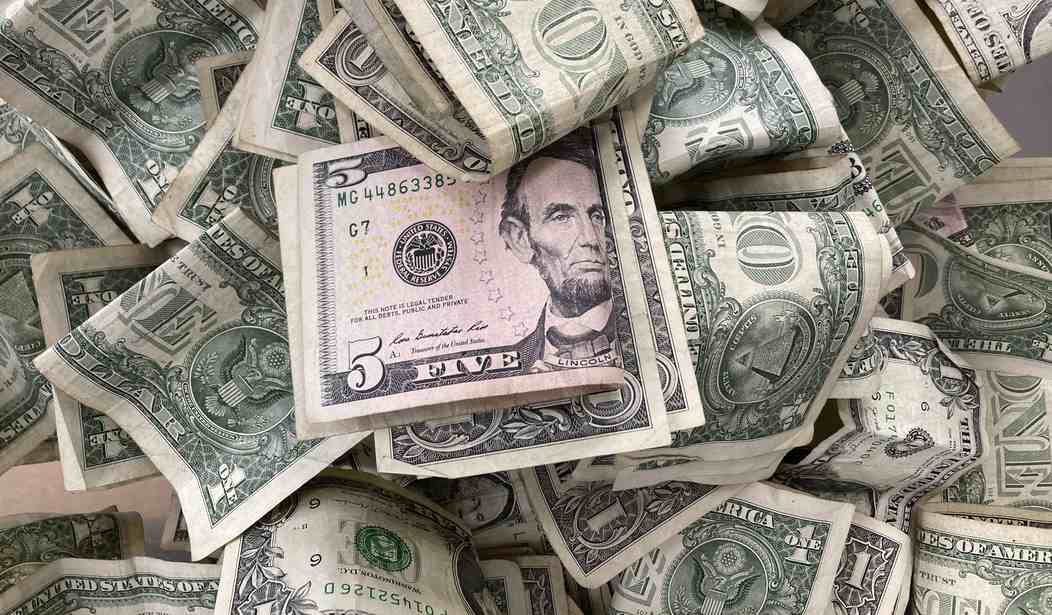See Wednesday’s article for Part One.
The convergence of our indulgent government spending, irresponsible fiscal and monetary policy, and out-of-control debt crisis has a direct causal link to the waning global confidence in the U.S. dollar, foreshadowing the potential collapse of “dollar hegemony.” A recent study by the International Monetary Fund shows a significant decrease in the dollar’s share of foreign central banks’ exchange reserves, which has declined from 71.5 percent to 59.2 percent in the past two decades. Extrapolating this current trend would, as Wolf Richter analyzes, lead to the dollar’s share falling below 50 percent within 10 years.
Concurrent to this decrease in confidence has been a growing clamor to replace the dollar – the global reserve currency since the end of World War II – with a supposedly more egalitarian and stable global denomination. Much of this advocacy for change comes from U.S. rivals such as China and Russia, globalist elites furthering their own various political and economic agendas, and bloated international organizations seeking to expand their power and influence.
The dollar was designated as the world reserve currency in 1944 via the Bretton Woods Agreement, which sought to create a more orderly, efficient, and stable global financial system to avoid another Great Depression. One of the key elements to this system was the creation of a uniform currency exchange rate. The mechanism by which this was accomplished was two-fold: First, all state signatories of the agreement would peg the value of their currency relative to the U.S. dollar; second, the dollar would, in turn, be pegged to the value of gold.
The other major piece of the Bretton Woods Agreement was the creation of two new international organizations that fall under the umbrella of the United Nations: The World Bank and the aforementioned International Monetary Fund (IMF).
The latter was designated as the overseer of the new currency exchange system. Over time, it has become essentially the global central bank for all domestic central banks.
Over the next 25 years, the IMF gained power and influence, especially as its membership exponentially increased in the wake of decolonization and the increase in the number of sovereign states.
Then, 1971 happened.
The U.S. economy’s “stagflation” during the 1970s was not the only casualty of LBJ’s reckless spending initiatives. The dollar had lost so much value due to this expansionary policy that President Nixon decided to remove the United States from the gold standard entirely, transforming the dollar into a fiat currency, rather than one based on inherent value.
Once the dollar became fiat, the global monetary system followed suit. This gave enormous power to central banks such as the Federal Reserve to conduct expansionary policy at will, with little in the way of natural checks and balances. It essentially gave central banks a blank check to print money at their discretion, a power they have abused considerably.
In 1971, the national debt of the United States was a modest $398 billion, roughly 35 percent of U.S. GDP.
Today, it stands at approximately $28.4 trillion, dwarfs U.S. GDP at 130 percent, and represents a 7,000 percent increase since the Fed was unleashed 50 years ago.
The debt to GDP ratio is crucial to distinguish. A debt to GDP ratio of 130 percent is astronomically higher than the number most experts point to as a healthy economic indicator. To put it in perspective, Japan’s debt to GDP percentage is nearly 225 percent. As previously mentioned, Japan’s economy – at one time the fastest growing and the second largest in the world – has completely flatlined and is trending downward.
A recent study by the World Bank examined debt to GDP in an effort to find the threshold level at which a nation risks losing significant GDP growth and approaches economic stagnation. The authors determined that threshold to be from 64 to 77 percent, depending on the fortitude of a country’s economy, and conclude:
“If debt explosions move debt ratios above the threshold and keep them there for decades…economic growth is likely to suffer.”
The United States is on the brink of a “debt explosion,” and there are zero signs of our leaders reining in our enormous debt accumulation in service of imprudent and politically motivated government spending initiatives.
A quarterly analysis of U.S. debt to GDP levels by the St. Louis Federal Reserve indicates the United States surpassed the 77 percent threshold in the first quarter of 2009. We have not come close to reducing it below 100 percent in the past six years.
In the absence of a significant shift in our nation’s fiscal and monetary priorities and general approach to economic policy, the inescapable reality is that the U.S. economy and the dollar are each losing their supremacy on the world stage.
What, then, might take the dollar’s place?
Some posit the Chinese renminbi; others, the Euro.
Yet, the greatest threat could come from an entirely more dangerous source: the International Monetary Fund.
To briefly circle back to the 1970s – the IMF found itself on unsure footing in the wake of the gold standard’s abandonment. However, just as central banks across the globe took advantage of their newfound latitude, the IMF followed suit, using this paradigm shift to completely realign its organizational goals. The IMF’s new focus became providing short-term loans to struggling or developing economies, while also conducting global economic surveillance.
It also began to circulate its own personal currency: special drawing rights (SDRs).
Increasing the circulation and use of SDRs has become a priority for many around the globe, especially those in China and other great powers who desire greater influence, as well as globalist elites who see tangible benefits to such a transition.
Zhou Xiaochuan, in his former capacity as governor of the People’s Bank of China, proposed that the SDR should entirely replace the dollar as the world reserve currency and be disconnected from any sovereign nation’s currency, describing the SDR as “the light in the tunnel.”
It is certainly not the light at the end of our tunnel.
The world is quickly approaching another economic flashpoint similar to 1944 and 1971, hastened by the onset of COVID-19, and America’s fate rests squarely on the impending decisions our leaders make.
Unfortunately, our country’s current leadership seems to be incapable of grasping the enormity of the situation. One possibility is they possess such little knowledge of economic theory that they simply do not understand the risk to our long-term economic health (which is entirely possible). Or they know exactly what they are doing, yet are willingly subordinating America’s economic health to further their own personal agendas, and/or the objectives of the globalist institutions they serve.
Consider that Treasury Secretary Janet Yellen is actively bypassing Congress to allocate astounding amounts of U.S. taxpayer dollars to the IMF, specifically for the purpose of advancing the dissemination of SDRs to foreign nations. Further, consider the governance structure of the IMF. It is led by a single managing director (traditionally from Europe) and a Governance Committee almost entirely comprised of the heads of central banks throughout the world. Heads of central banks such as Zhou Xiaochuan.
Consider that if the IMF’s SDR becomes the successor to the dollar, there would be no checks on its power, such as the United States Constitution, separation of powers, or representational decision-making of any kind. Global economic policy would be commanded from on high by a group of self-serving global elites from their yachts in Davos.
We are coming chillingly close to this eventuality.
Jack McPherrin is an editorial intern at The Heartland Institute.













Join the conversation as a VIP Member